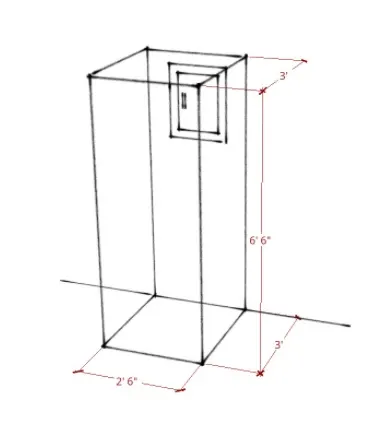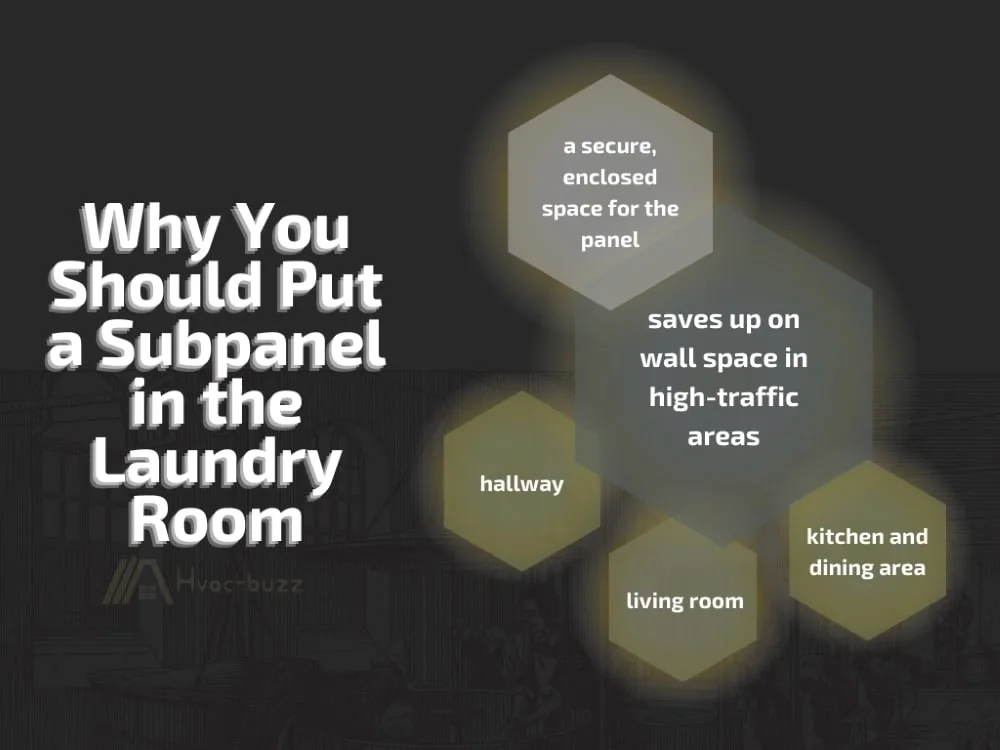Home to the washer, dryer, iron, and often a number of other appliances, having a subpanel in the laundry room makes sense. It’s also more likely to be a purely functional room where wall décor is less important, so a subpanel is not going to be an eyesore in the laundry room.
Let’s look at the recommended (and legal!) requirements when it comes to installing subpanels in laundry rooms or moving the laundry into a room that has a subpanel in it.

A subpanel can be installed in a laundry room if the working space (36” deep, 30” wide, and 6’6” high) is kept free of pipes, appliances, and stored items. The laundry room also needs artificial, non-automatic illumination. Dryers should be properly vented to prevent lint build-up.
Working Space for a Subpanel in the Laundry Room
The general requirements for installing subpanels can be found in Section E3405.1 and Section E3405.2 of the International Residential Code. These sections include the dimensions of the working area of a subpanel:
- The area in the wall extended from the ground to 6’6” (or to the top of the subpanel if it is taller than this height).
- 36” depth measured from the front of the subpanel.
- 30” width in front of the panel (or the width of the panel if it is wider than 30”).
- The 36” x 30” area will also extend 6’6” in height.
You can see this area illustrated in the figure below.

This working area needs to allow the subpanel equipment doors to be opened to at least 90 degrees. If this means that it has to be larger than the above dimensions, then it has to be larger.
For a subpanel to be installed in the laundry room, you will need to make sure that the working space is clear.
This means that no pipes, ducts, or unrelated electrical equipment can be installed in this area or even extend into this area. Furthermore, you cannot store anything in this area, not even temporarily.
What’s the Importance of the Working Space?
The working space dimension requirements exist for the same reason most of the building codes exist: safety.
Should there be an emergency, you, an electrician, or emergency service personnel will need easy access to the subpanel. Furthermore, storing items in this area is a fire hazard, particularly if they are flammable by nature (so keep laundry hampers well away!).
Even simple maintenance and repairs would be difficult if the space was smaller or filled with other fixtures and items; you don’t want to be contorting your arms and hands to weird angles while working with electricity.
Illumination Requirements
As per Section E3405.1, the working space has to be illuminated with artificial lighting. Furthermore, the lighting cannot be automatically controlled.
The reason that this stipulation exists is that you have to be able to view the subpanel at all times and in all circumstances.
Washer and Dryer Next to Subpanel
If you are installing your subpanel in the laundry room, then the chances are that it will be next to the washer and or dryer. Are there any problems with this?
Washers and Subpanels
I don’t know about you, but my own immediate concern with a washer being next to the subpanel is the thought of water getting onto the electrical panel!
Of course, this is something you have to watch out for, but, happily, washers are unlikely to cause splashes. Moreover, if the water pipes have been installed according to code, then there should not be any issues. Wires and pipes run together all the time in a house.
Dryers and Subpanels
Then, when I was thinking out about my dryer being in close proximity to the subpanel, I had visions of lint build-up and raging fires! However, if your dryer is installed correctly, then there should be no lint build-up. Additionally, the subpanel casing is also designed to keep things like lint out of it.
However, I would still be diligent with cleaning the laundry room and emptying the lint filters of the dryer often.
You can read about venting dryers correctly in the following two articles:
Keep the Working Space Clear
While keeping the washer and dryer next to the subpanel shouldn’t pose any great issues, they most certainly cannot be placed in the subpanel’s working space.
Imagine being the on-call electrician or electrical engineer and having to go through heavy appliances first just to get to the actual task at hand.
Similarly, in case of an emergency like floods or rolling power outages, imagine yourself having to gear up for safety and moving heavy high-voltage objects out of the way before you can cut off the power supply. It takes up time and effort and increases the likelihood of undesired electrical or fire incidents occurring.
I Have a Sink in my Laundry Room
Having a sink in your laundry room does not change the minimum work clearance space that must be kept free and open. Technically, you need no greater distance between a sink and subpanel than a shelf and a subpanel.
However, to err on the side of caution, I would recommend keeping the sink as far from the subpanel as possible because, unlike a washer, splashing is almost guaranteed with a sink.
Related article: Can You Put a Subpanel in a Bathroom
Can I Put the Panel in Front of or Behind the Door?
To tuck a subpanel on the wall behind your laundry room door might seem like a great solution; the door will be able to enter the subpanel’s working space and is therefore not permitted.
What about the walls adjacent to the doorway? Are there any rules about putting a subpanel there?
I cannot find any regulations against installing a subpanel on the wall adjacent to a doorway as long as the door does not slide or swing over the subpanel and provided you do no leave items lying in front of the subpanel in the working space.
Why It’s a Good Idea

When all the requirements are met, putting a subpanel in the laundry room is a great way to save up on wall space in high-traffic areas like the hallway, living room, kitchen, and dining room.
It’s a great way to keep your electrical panel in a safe enclosed space, too, without sacrificing a significant amount of space in other rooms that could otherwise be used for greater functionality.
Sources
https://everythingwhat.com/can-a-electrical-panel-be-in-a-laundry-room
https://www.hunker.com/12492226/can-i-install-an-electrical-panel-in-the-laundry-room
https://www.familyhandyman.com/list/breaker-panel-smarts/
https://www.diychatroom.com/threads/proper-placement-for-breaker-panel-in-laundry-room.133661/
https://forums.mikeholt.com/threads/sub-panel-in-laundry-room-3-5-feet-from-sink.107897/
https://www.electriciantalk.com/threads/sub-panel-in-laundry-dryer-closet.197482/
